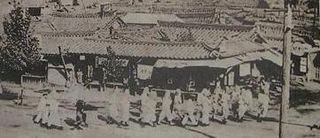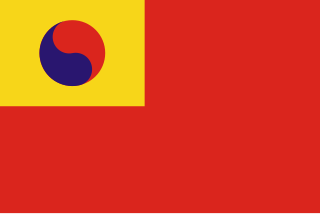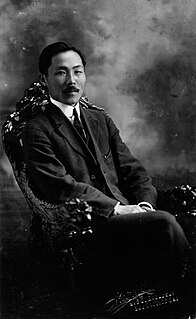 W
WThe Korean independence movement was a military and diplomatic campaign to achieve the independence of Korea from Japan. After the Japanese annexation of Korea in 1910, Korea's domestic resistance peaked in the March 1st Movement, which was crushed and sent Korean leaders to flee into China. In China, Korean independence activists built ties with the National Government of the Republic of China which supported the Provisional Government of the Republic of Korea (KPG), as a government in exile. At the same time, the Korean Liberation Army, which operated under the Chinese National Military Council and then the KPG, led attacks against Japan.
 W
WThe 105-Man Incident or Seoncheon Incident took place while Korea was under Japanese rule.
 W
WThe Down-with-Imperialism Union, or DIU, was founded on 17 October 1926 in Huadian city, Jilin province, China, in order to fight against Japanese imperialism and to promote Marxism–Leninism. It is considered to be the root and foundation of the Workers' Party of Korea and its creation is celebrated every year.
 W
WTatsuji Fuse was a Japanese lawyer and social activist. Fuse was posthumously awarded the Order of Merit for National Foundation in 2004 by the South Korean government for his efforts for Korean independence movement.
 W
WThe Korean Liberation Army, established on September 17, 1940 in Chungking, China, was the armed force of the Provisional Government of the Republic of Korea. Its commandant was General Ji Cheong-cheon, with General Lee Beom-seok, a hero of the Battle of Cheongsanri and future prime minister of South Korea as the Chief of Staff. Effectively a part of the Chinese forces upon which it was dependent, the army was limited by available manpower and did not get much above 339 strong. The KLA became the basis of the modern day Republic of Korea Armed Forces.
 W
WThe Korean National Association, also known as All Korea Korean National Association, was a political organization established on February 1, 1909, to fight Japan's colonial policies and occupation in Korea. It was founded in San Francisco by the intellectual scholar and Korean Independence activist Ahn Changho, and represented the interests of Koreans in the United States, Russian Far East, and Manchuria during the Korean Independence Movement.
 W
WThe Korean National Revolutionary Party, or KNRP, was a nationalist party formed by exiles in Shanghai in 1935 to resist the Japanese occupation of Korea. At first it was the main nationalist Korean political party, but as the Sino-Japanese War (1937–45) progressed the rival Korean National Party, later Korea Independence Party, gained more influence with the Chinese Nationalist government in Chongqing and came to dominate the Korean Provisional Government. The KNRP of America was a significant factor as a source of funds and a link to the US government. The KNRP was dissolved in 1947.
 W
WKorean Patriotic Organization, also known as Korean Patriotic Corps or Korean Patriotic Legion, was a secret organization that aimed to assassinate prominent Japanese figures of the Empire of Japan. It was one of the independence movements propelled by the Provisional Government of the Republic of Korea. The Korean Patriotic Organization was founded by Kim Gu, president of the Provisional Government of the Republic of Korea. Its executives were Kim Suk, Ahn Gong-geun, Lee Su-bong, and Lee Yu-pil. Notable members included Yoo Sang-geun, Yoo Jin-man, Yun Bong-gil, Lee Bong-chang, Lee Duk-ju, and Choi Heung-sik.
 W
WThe March 1st Movement, also known as the Sam-il (3-1) Movement, was one of the earliest public displays of Korean resistance during the rule of Korea by Japan from 1910 to 1945. The event occurred on March 1, 1919, hence the movement's name, literally meaning "Three-One Movement" or "March First Movement" in Korean. It is also sometimes referred to as the Man-se Demonstrations.
 W
WThe National Liberation Day of Korea is a holiday celebrated annually on 15 August in both South and North Korea. It commemorates Victory over Japan Day, when at the end of World War II, the U.S. and Soviet forces helped end 35 years of Japanese occupation and colonial rule of Korea that lasted from 1910-1945. It is notable for being the only Korean public holiday celebrated by both South and North.
 W
WSinhan Minbo or The New Korea was a Korean-American newspaper founded on February 10, 1909, by the Korean National Association (KNA). It was based in San Francisco and published weekly. The newspaper became a vital part in promoting nationalism amongst Korean immigrant communities and spreading news on the issue of Korean independence. It would be the most influential and longest lasting newspaper for Korean Immigrants in the US.
 W
WThe New People's Association, established in April 1906 was a clandestine organization for fostering the independence and national strength of the Korean Empire. The organization was formed by social activists such as Ahn Changho, Shin Chaeho, Park Eunsik, and Lim Chi Jung.
 W
WThe Korean Provisional Government (KPG), formally the Provisional Government of the Republic of Korea, was a partially recognized Korean government-in-exile based in Shanghai, China, and later in Chungking, during the Japanese colonial rule of Korea.
 W
WThe Sakuradamon incident or Patriotic Deed of Lee Bong-chang was an assassination attempt against Emperor Hirohito of the Empire of Japan by a Korean independence activist, Lee Bong-chang, in Tokyo on 9 January 1932.
 W
WSong of Ariran is a book of reportage by an American journalist, Helen Foster Snow under the name Nym Wales. Snow traveled to Yan'an, the wartime capital of the Chinese Communist Party, which welcomed and supported many Koreans in the fight for independence from Japan. The colorful and personal information on the history of the Korean independence movement and the Chinese Communist movement in the 1930s is based on extensive interviews with a Korean communist Jang Jirak who is called Kim San in the book.